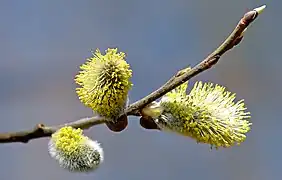A catkin or ament is a slim, cylindrical flower cluster (a spike), with inconspicuous or no petals, usually wind-pollinated (anemophilous) but sometimes insect-pollinated (as in Salix). They contain many, usually unisexual flowers, arranged closely along a central stem that is often drooping. They are found in many plant families, including Betulaceae, Fagaceae, Moraceae, and Salicaceae.
Occurrence
Catkin-bearing plants include many trees or shrubs such as birch, willow, aspen, hickory, sweet chestnut, and sweetfern (Comptonia).
In many of these plants, only the male flowers form catkins, and the female flowers are single (hazel, oak), a cone (alder), or other types (mulberry). Such as Corylus jacquemontii has male catkins and also female spikes.[1] In other plants (such as poplar), both male and female flowers are borne in catkins. Such as Populus alba has male catkins which are grey and the female catkins are greyish-green.[2]
While the blooming months for catkins may vary due to factors such as climate change, the following are some general timeframes: Hazel catkins bloom from January to March, alder catkins from February to March, silver birch catkins from March to May, oak catkins from April to May, and white willow catkins from April to May.[3]
In Britain, catkins can be seen in January or February, when many trees are bare for winter. They can even occur in December.[4]
Evolution
For some time, catkins were believed to be a key synapomorphy among the proposed Hamamelididae, also known as Amentiferae (i.e., literally plants bearing aments). Based on molecular phylogeny work, it is now believed that Hamamelididae is a polyphyletic group.[5][6] This suggests that the catkin flower arrangement has arisen at least twice independently by convergent evolution, in Fagales and in Salicaceae.[7] Such a convergent evolution raises questions about what the ancestral inflorescence characters might be and how catkins did evolve in these two lineages.
Etymology

The word catkin is a loanword from the Middle Dutch katteken, meaning "kitten" (compare also German Kätzchen). This name is due either to the resemblance of the lengthy sorts of catkins to a kitten's tail, or to the fine fur found on some catkins.[8][9] Ament is from the Latin amentum, meaning "thong" or "strap".[10]
Gallery
- Catkins in Fagales
 Male catkins of hop-hornbeam (Ostrya carpinifolia)
Male catkins of hop-hornbeam (Ostrya carpinifolia) Young male catkins of hazel (Corylus avellana)
Young male catkins of hazel (Corylus avellana) Mature male catkins of hazel (Corylus avellana)
Mature male catkins of hazel (Corylus avellana).jpg.webp)
- Catkins in Salicaceae



References
- ↑ "Jacquemont's Hazel". flowersofindia.net. Retrieved 7 July 2020.
- ↑ Flora of NW Europe: Populus alba Archived 2010-08-27 at the Wayback Machine
- ↑ Trust, Woodland. "Which trees have catkins and how to ID them". Woodland Trust. Retrieved 2023-02-23.
- ↑ Rose Sanderson (2015-01-30). "An early catkin year". BBC Earth. Archived from the original on 2019-01-06. Retrieved 2022-11-25.
- ↑ Savolainen, V., M. W. Chase, S. B. Hoot, C. M. Morton, D. E. Soltis, C. Bayer, M. F. Fay, A. Y. De Bruijn, S. Sullivan, and Y.-L. Qiu. 2000. Phylogenetics of flowering plants based on combined analysis of plastid atpB and rbcL gene sequences. Systematic Biology 49:306-362.
- ↑ Soltis, D. E. et alii. (28 authors). 2011. "Angiosperm phylogeny: 17 genes, 640 taxa". American Journal of Botany 98(4):704-730. doi:10.3732/ajb.1000404
- ↑ Cronk Q. C. B., Needham I., and Rudall P. J. 2015. Evolution of catkins: inflorescence morphology of selected Salicaceae in an evolutionary and developmental context. Frontiers in Plant Science. 2015; 6: 1030. doi:10.3389/fpls.2015.01030
- ↑ "Catkin", Oxford English Dictionary (Second ed.), 1989, retrieved 30 November 2009
- ↑ "Zoekresultaten". www.etymologiebank.nl.
- ↑ "Ament", Oxford English Dictionary (Second ed.), 1989, retrieved 30 November 2009
